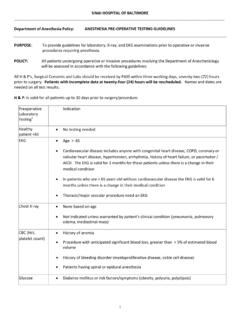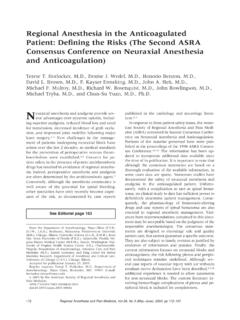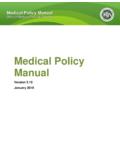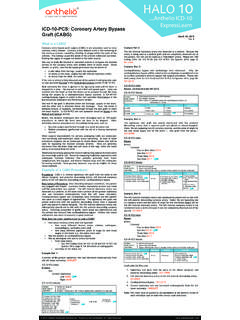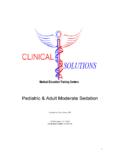Transcription of Lumbar puncture in patients using anticoagulants …
1 679 DOI: VIEW AND REVIEWL umbar puncture in patients using anticoagulants and antiplatelet agentsPun o lombar em pacientes usando anticoagulantes e agentes antiplaquet riosRenan Domingues1, Gustavo Bruniera1, 2, Fernando Brunale1, 2, Crist v o Mangueira2, Carlos Senne1,2 Lumbar puncture (LP) is the most used technique for ob-taining cerebrospinal fluid (CSF). CSF analysis is crucial in the diagnosis of a variety of infectious and noninfectious neu-rologic conditions1. LP is a relatively safe procedure, but com-plications such as post-LP headache, infection, and bleeding may occur. Minor bleeding is characterized by the presence of red blood cells in the CSF. Spinal hematoma is a rare com-plication but its risk increases in patients with any bleeding predisposing condition. Spinal hematoma presents with back pain and neurologic findings such as weakness, reduced sen-sation, and incontinence2.
2 The true incidence of hemorrhagic complications associated with diagnostic LP is unknown, but it is estimated to be less than 1/220,000 for spinal anesthetics3. The use of anticoagulants and antiplatelet agents has grown4,5,6 due to the aging of the population and the availability of a wider range of drugs for prevention and treat-ment of vascular diseases7,8. patients using these drugs have increased risk of bleeding complications when submitted to LP. Neurologists and other physicians that order and/or per-form spinal tap should be aware of that and should carefully evaluate the risks and benefits of maintaining or discontinu-ing the medication prior LP. There are not many studies examining the risk of bleed-ing after LP in patients using anticoagulants and antiplate-let agents.
3 Clear recommendations are lacking in this regard. Three issues have to be considered when a physician is faced with a patient in need of a LP and using one or some of these drugs. It is possible to reduce bleeding risk by discontinuing or reversing the effect of these drugs. In the other hand it is crucial to take into account the increased thrombotic risk 1 Senne L quor Diagn stico, S o Paulo SP, Brasil; 2 Hospital Israelita Albert Einstein, Laborat rio de Patologia Cl nica, S o Paulo SP, : Renan Domingues; Senne L quor Diagn stico; Rua Maestro Cardim, 560 / sala 2; 01323-001 S o Paulo SP, Brasil; E-mail: of interest: There is no conflict of interest to 20 January 2016; Accepted 25 May use of anticoagulants and antiplatelet agents has largely increased. Diagnostic Lumbar puncture in patients taking these drugs represents a challenge considering the opposing risks of bleeding and thrombotic complications.
4 To date there are no controlled trials, specific guidelines, nor clear recommendations in this area. In the present review we make some recommendations about Lumbar puncture in patients using these drugs. Our recommendations take into consideration the pharmacology of these drugs, the thrombotic risk according to the underlying disease, and the urgency in cerebrospinal fluid analysis. Evaluating such information and a rigorous monitoring of neurological symptoms after Lumbar puncture are crucial to minimize the risk of hemorrhage associated neurological deficits. An individualized patient decision-making and an effective communication between the assistant physician and the responsible for conducting the Lumbar puncture are essential to minimize potential : anticoagulants ; platelet aggregation inhibitors; spinal puncture ; hematoma, uso de anticoagulantes e de agentes antiplaquet rios tem aumentado nos ltimos anos.
5 A realiza o de pun o lombar diagn stica em pacientes utilizando tais medicamentos representa um desafio, em fun o dos riscos de complica es hemorr gicas ou tromb ticas, estas ltimas em pacientes que interrompem o tratamento para a realiza o do procedimento. N o h ainda estudos controlados nem diretrizes espec ficas nesta rea. Neste artigo de revis o, algumas recomenda es s o feitas, levando-se em conta aspectos farmacol gicos destas medica es, o risco de complica es tromb ticas de acordo com a doen a de base, e a urg ncia na coleta do l quor. A avalia o cuidadosa destas informa es e uma monitoriza o neurol gica rigorosa visando a detec o e o tratamento precoce de complica es podem reduzir o risco de sequelas neurol gicas decorrentes de hemorragia. Uma decis o individualizada e uma efetiva comunica o entre o m dico assistente e o respons vel pela realiza o da pun o lombar essencial para minimizar potenciais : anticoagulantes; inibidores da agrega o de plaquetas; pun o espinal; hematoma espinhal.
6 680 Arq Neuropsiquiatr 2016;74(8):679-686associated with this discontinuation. It is also important to consider that in many instances, in which CSF analysis is an emergence, it is not possible to wait for the reversal of phar-macological effects of such drugs. In this critical review we discuss the risk of LP associat-ed bleeding in patients using anticoagulants and antiplate-let agents and make some practical recommendations taking into account these three major issues. ORAL ANTIPLATELET TREATMENTSOral antiplatelet agents comprise a group of drugs that interfere with the formation of thrombi on atherosclerotic plaques. Antiplatelet agents are effective in reducing the risk of diseases such as myocardial infarction, ischemic stroke, and peripheral arterial disease9. AspirinAspirin (acetylsalicylic acid) is the most used antiplate-let drug worldwide10.
7 Aspirin is largely used in the prevention of coronary disease, stroke, and peripheral vascular disease. patients in use of aspirin have an increased risk of bleed-ing11. The spinal tap bleeding risk in patients using aspirin has been studied. One case report showed spinal subdural hematoma in a patient submitted to LP using aspirin12,13. In a prospective study, Horlocker et cols. evaluated the data of 924 patients given spinal or epidural anesthesia. Among those patients 193 were using aspirin. None out of these pa-tients had major hemorrhagic complications and 47 ( ) had minor hemorrhagic complications14, suggesting a very low LP associated major bleeding risk associated with aspi-rin. In the other hand there is a considerable risk of vascular complications among patients in which aspirin is discontin-ued.
8 In a previous study this risk was estimated to be Given the low risk of bleeding associated with its use and the high risk of ischemic complications associated with aspi-rin interruption, we propose that aspirin is not interrupted for performing , clopidogrel, and the more recently intro-duced plasugrel are ADP platelet receptor inhibitors widely used for acute coronary syndromes, after stent placement, and more rarely for secondary prevention of cerebrovascu-lar and peripheral ischemia16,17,18. Clopidogrel is frequently used in the form of dual antiplatelet therapy, which consists in combination of aspirin and clopidogrel19. The risk of bleeding after diagnostic and therapeutic proce-dures increases with the use of these drugs, and this increased risk persists for a few days after cessation of these drugs.
9 After com-plete interruption the clopidogrel effect lasts from 5 to 7 days, ticlopidine from 10 to 14 days, and plasugrel from 7 to 9 days20. There is little information on LP associated bleeding risk in patients using thyenopyridines. Some studies assessed the clopidogrel associated bleeding risk in patients submitted to spinal anesthesia and other medical procedures. In general, these studies showed a low clopidogrel associated bleeding risk21,22,23,24,25. However, this risk is higher and potentially seri-ous in patients using clopidogrel in combination with aspi-rin. Paal and cols. described a case of subarachnoid hemor-rhage after a diagnostic LP performed with a fine needle in a patient using aspirin and clopidogrel26. In view of this risk the American Society of Regional Anesthesia (ASRA) proposed that clopidogrel should be dis-continued for 7 days before spinal anesthesia27.
10 On the other hand, it is well known that clopidogrel discontinuation may be associated with increased risk of ischemic events in high-risk patients16,17,18. Therefore, the decision must be individualized taking into consideration the thrombotic risk and the urgency in CSF analysis. In patients with high cardio or cerebrovascu-lar risk, for instance, in a patient with recent stent placement, we propose that LP should be done regardless the use of clopi-dogrel. We also recommend not discontinuing thyenopyridine when CSF analysis is urgent for diagnosing a potentially seri-ous and acute CNS disease. Thyenopyridine may be interrupt-ed for an elective LP in a patient with low cardiovascular and cerebrovascular ischemic risk. In those cases aspirin, which is associated with a lower risk of bleeding, can be used (Table 1).










